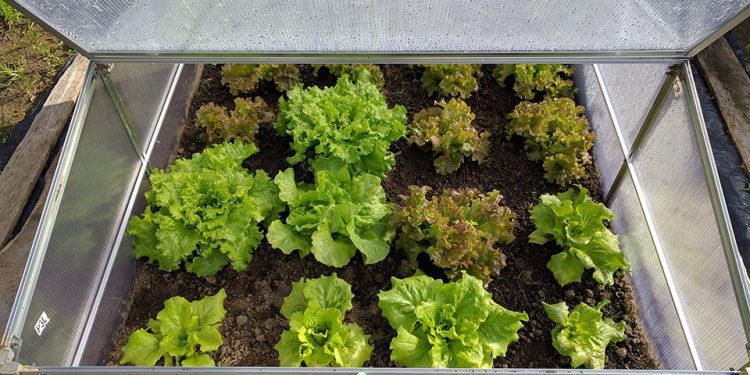Lettuce is the perfect winter plant for your greenhouse. This leafy plant likes a cool environment. Therefore, you don’t have to heat your greenhouse as much as for other plants in winter. This cool-weather vegetable comes in different shapes and will provide you with nutrients throughout the season. Lettuce is rich in Folate, Manganese, Vitamins A, C, K, and dietary fiber. It is a component of many salad dishes although chefs around the world use it in soups, wraps, and sandwiches as well. Let’s have a look at how you can grow lettuce in a greenhouse!
Planting lettuce in a greenhouse
- If you want to plant it in the ground: Plant the lettuce seeds as soon as the soil is workable, preferably one or two weeks before the last spring frost date although you can start a little earlier because greenhouse conditions provide adequate protection against harsh effects of the elements.
- If you plant lettuce in seed trays or containers: Spread the seeds over the soil in the seed tray. Then, pour the seeds with a shallow cover of added soil, pressing underneath gently with your fingers
- You can sow the seeds spacing them about 8 and 16 inches apart in rows that are 12 inches apart, or, you can broadcast them. The spacing depends on the variety. For instance, preferred spacing for leaf lettuce is 8 inches apart while loose-headed and firm-headed varieties do well when planted 8 inches and 16 inches apart respectively
- Cover the seeds with about half an inch of soil and water adequately. To ensure proper germination, the soil temperature should be between 65 and 70 degrees Fahrenheit

Tips and Tricks
- Artificial methods like heating or cooling
- Your greenhouse may have ventilation systems and these can be customized based on the temperature outside
- While snow is not necessarily detrimental to lettuce, avoid exposing them to desiccating cold as this will kill them
- Plant rows of either garlic or chives close by to help control aphids
- Secure access to electricity is very important. You might slip into some extension cords to power your artificial heat and light sources
Common Problems
Lettuce is susceptible to some common problems like attacks by earwigs, cutworms, and aphids. Woodchucks and rabbits are harmful as well.
Adult lettuce leaves become bitter and woody and it may go rot soon, so check them every day.
Before the weather warms up in the summertime, cover your lettuce with shade cloth which will delay the plants’ tendency to dry and stretch the harvest toward the hot summer.
Like it? Pin it!
How to Grow Lettuce – The Requirements
Temperature
Maintain the greenhouse temperature between 50 and 70 degrees Fahrenheit throughout the day. If it becomes warm outside, open the doors cool off the air indoors. The excellent evening temperatures are between 45 degrees Fahrenheit and 55 degrees Fahrenheit. It can withstand the short cold spells at 35 degrees Fahrenheit, particularly when they are protected inside your greenhouse. Some days at 90 degrees Fahrenheit will only stress your lettuce but won’t possibly destroy it. Keep the soil moistened and distribute sufficient cool air as possible throughout the warm seasons.
Watering
Lettuce requires adequate watering during all stages of growth. Water the seed tray with a light mist, making sure that the soil is moistened and well-drained. You can utilize a misting system to automatically humidify your lettuces without producing too much moisture. Overall, supply an inch of water every week.
Seedlings benefit from being sprinkled immediately following transplanting with a light solution of seaweed or fish emulsion. Lettuce like other greens are shallow-rooted and they develop quickly. They require constant access to lots of water to yield tender, luscious leaves.
Soil
Lettuce thrives abundantly in rich, loamy soil that includes lots of organic material. Before you plant your seedlings, you may use a hand fork to dig fertilizer within the first two inches of soil. They do well in rich, well-drained soil with soil pH ranging between 6.0 and 7.0. Have a consistently moistened soil so they don’t grow stressed. Sowing seeds each week will surely supply you with more lettuce than you can consume. Successive sowing is the simplest process to increase satisfying results.
Lighting
Lettuce requires broad daylight. Place your greenhouse in a place where it receives at least six hours of direct sunlight every day or you may invest in a lighting kit. A south-facing spot is the best.
Harvesting
Because lettuce is best when tender, harvesting just before they mature is recommended. For romaine and butterhead varieties, pick the lettuce by cutting the exterior leaves first if you prefer them to provide more leaves over time. It is best to pick lettuce early in the morning before its leaves have been displayed to the sunlight.












